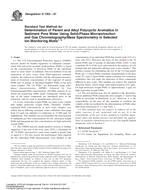1.1 The U.S. Environmental Protection Agency (USEPA) narcosis model for benthic organisms in sediments contaminated with polycyclic aromatic hydrocarbons (PAHs) is based on the concentrations of dissolved PAHs in the interstitial water or “pore water” in sediment. This test method covers the separation of pore water from PAH-impacted sediment samples, the removal of colloids, and the subsequent measurement of dissolved concentrations of the required 10 parent PAHs and 14 groups of alkylated daughter PAHs in the pore water samples. The “24 PAHs” are determined using solid-phase microextraction (SPME) followed by Gas Chromatography/Mass Spectrometry (GC/MS) analysis in selected ion monitoring (SIM) mode. Isotopically labeled analogs of the target compounds are introduced prior to the extraction, and are used as quantification references.
1.2 Lower molecular weight PAHs are more water soluble than higher molecular weight PAHs. Therefore, USEPA-regulated PAH concentrations in pore water samples vary widely due to differing saturation water solubilities that range from 0.2 µg/L for indeno[1,2,3-cd]pyrene to 31 000 µg/L for naphthalene. This method can accommodate the measurement of milligram per litre concentrations for low molecular weight PAHs and nanogram per litre concentrations for high molecular weight PAHs.
1.3 The USEPA narcosis model predicts toxicity to benthic organisms if the sum of the toxic units (TU
1.4 The test method may also be applied to the determination of additional PAH compounds (for example, 5- and 6-ring PAHs as described in Hawthorne et al). However, it is the responsibility of the user of this standard to establish the validity of the test method for the determination of PAHs other than those referenced in 1.1 and Table 1.
This standard does not purport to address all of the safety concerns, if any, associated with its use. It is the responsibility of the user of this standard to establish appropriate safety and health practices and determine the applicability of regulatory limitations prior to use.
Product Details
- Published:
- 08/01/2007
- Number of Pages:
- 23
- File Size:
- 1 file , 400 KB
